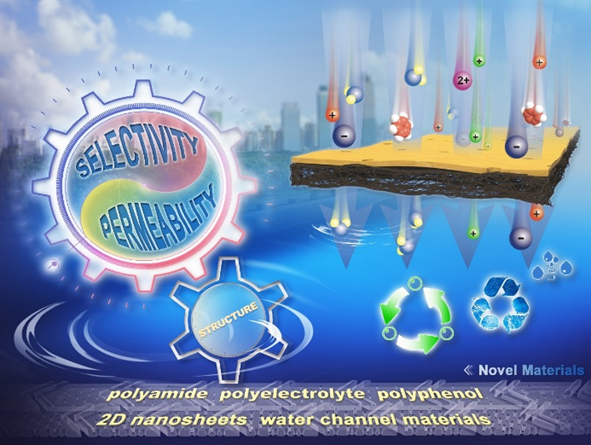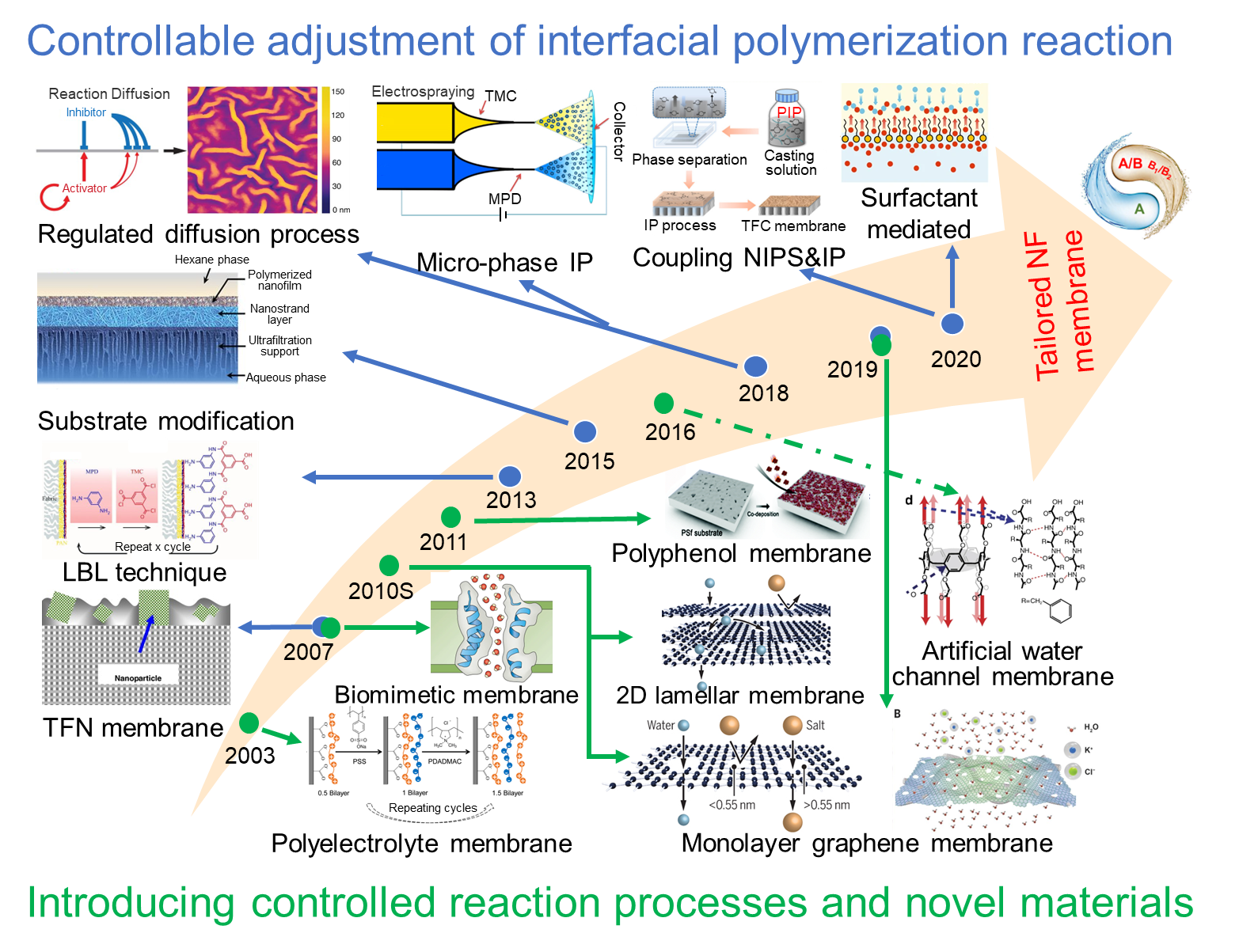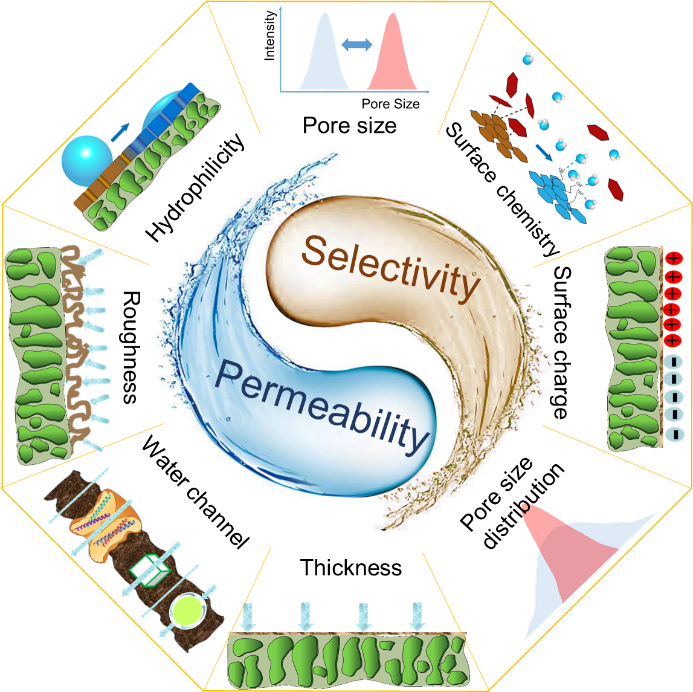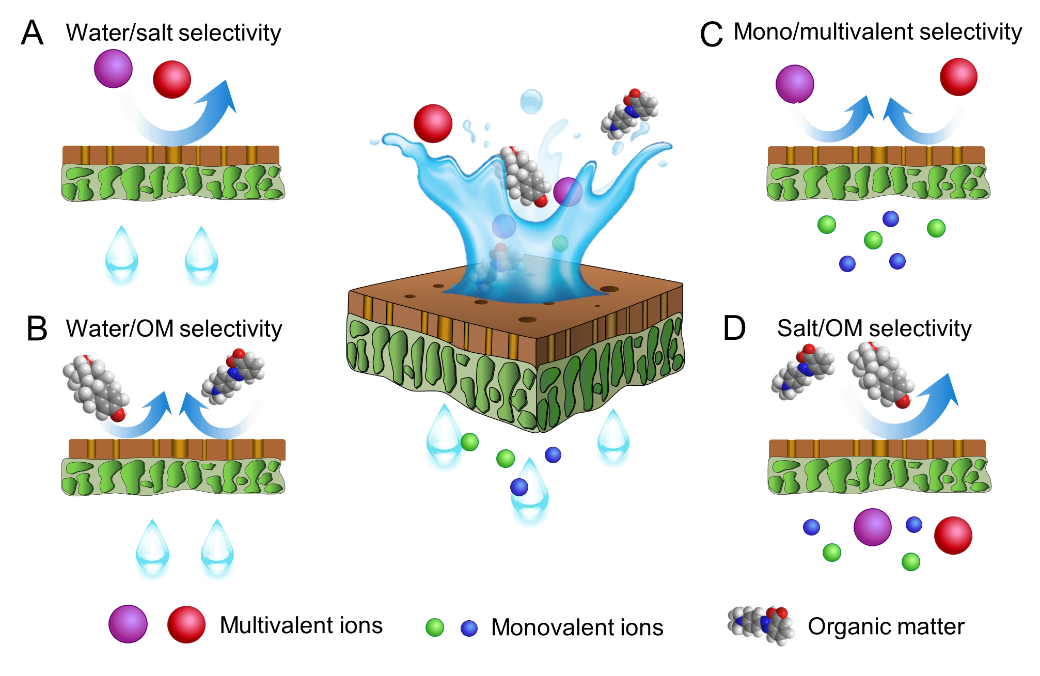Professor Huang Xia’s team at the School of Environment, Tsinghua University systematically reviewed the recent progress in nanofiltration (NF) membrane fabrication and comprehensively analyzed the synthesis-property-performance relationship with a purpose of directing the tailored design of NF membranes for the increasing and challenging demands in current and future water treatment . They refined the definition for the selectivity of NF membranes, established the tradeoff relationships between permeability and selectivity of NF membranes under different selectivity scenarios for the first time, and furtherly summarized membrane fabrication strategies and revealed the underlying mechanisms to break through the current tradeoff relationships. The research team also strengthened and substantiated the concept of tailored design of NF membranes for different water treatment applications and discussed future research priorities and directions.
NF membranes have subnanometer scale and tunable pore properties and abundant surface functional groups, which allows them to selectively remove or retain target solutes from water. In recent years, NF membranes have attracted extensive attention in the fields of drinking water security, wastewater reuse and recovery of valuable resources. However, the selectivity performance of commercial NF membranes are difficult to meet the separation requirements in many application scenarios and the water permeability of these membranes are relatively low, which limit the wider application of NF membranes in water treatment. Advancements in material science and the optimization of membrane fabrication provide effective solutions to improve the separation performance and efficacy of NF membranes. Therefore, a systematic summarization of the synthesis-property-performance relationships is helpful to build a bridge between nanofiltration membrane fabrication and water treatment application, and to realize the tailored design of NF membranes to meet different and challenging water treatment requirements.

Tailored design of NF membranes for different water treatment demands by regulating its properties through materials and fabrication technologies optimization.
The most fundamental way to tailored design of NF membranes is to controllably regulate membrane structure and surface chemistry during fabrication process. This article firstly reviewed the recent progress in controllable design of NF membrane structural and physicochemical properties by adopting new manufacturing processes and materials. On the one hand, the control of the traditional interfacial polymerization process is enhanced to fully exploit its potential by optimizing the substrate membrane structure, regulating the reaction process and post-treatment of nascent membranes. On the other hand, new materials and controllable reaction processes are used to achieve the directional control of NF membrane structural and physicochemical properties, such as layer-by-layer assembled polyelectrolyte membranes, polyphenol co-deposition membranes, bionic water channel membranes and 2D laminar membranes. After a systematic and in-depth analysis of the experimental data of nearly 400 papers, this article summarized the separation performance and prospects of NF membranes fabricated by different materials and processes.

Two ways to realize tailored design of NF membranes are enhancing the regulation of traditional interfacial polymerization reaction and introducing new controllable reaction processes and materials.
Based on the solute transport theory and mathematical models, this article systematically discussed the relationship between the structural and physicochemical properties and separation performance of NF membranes, analyzed the influence of NF membrane’s structure and surface chemistry on separation performance. Results show that the membrane water permeability can be enhanced by reducing the thickness of active layer, enlarging the effective water permeation area, constructing water channels for rapid permeation, and improving the hydrophilicity of active layer; its selectivity can be regulated by adjusting pore size and distribution, surface charge and hydrophobicity. On this basis, this paper further summarized the efforts made by researchers in recent years on different regulation strategies, revealed the underlying mechanism of different strategies through quantitative analysis of collected data, and then pointed out the problems in those strategies that await to be studied.

Relationships between the structural & physicochemical properties of NF membrane and its separation performance
The research systematically classified the selectivity of NF membranes into water/salt selectivity, water/OM (organic matter) selectivity, mono/multivalent ion selectivity, and salt/OM selectivity. According to the separation requirements of different application scenarios, the application status and prospects of current NF membranes with different materials and fabrication technologies were systematically discussed including the removal of disinfection byproduct precursors and trace organic compounds in municipal water treatment, softening of industrial feed water and zero discharge of high-salt wastewater, and the separation of lithium and magnesium from salt lake brine. This research aims to fill the long-standing gap between the urgent need for different types of high-performance NF membranes in water treatment and the large amount of academic literature on NF membrane fabrication published in recent years, and eventually shed light on the fabrication and regulation direction of NF membrane according to different requirements in water treatment.

Systematic classification of NF membrane selectivity
This article was published in Chemical Society Reviews with the title “Tailored design of nanofiltration membranes for water treatment based on synthesis-property-performance relationships”. Wang Kunpeng, PhD student in the School of Environment, was the first author of this paper. Prof. Huang Xia was the corresponding author. Associate Prof. Wang Xiaomao, PhD student Li Danyang, postgraduate student Fu Ruoyu, Assistant Prof. Liu Yanling from Tongji University, Prof. Menachem Elimelech and PhD student Brielle Januszewski from Yale University, all made important contributions to this research. This research was supported by the National Natural Science Foundation of China (51978367).
Link of the paper:https://pubs.rsc.org/en/content/articlelanding/2022/cs/d0cs01599





